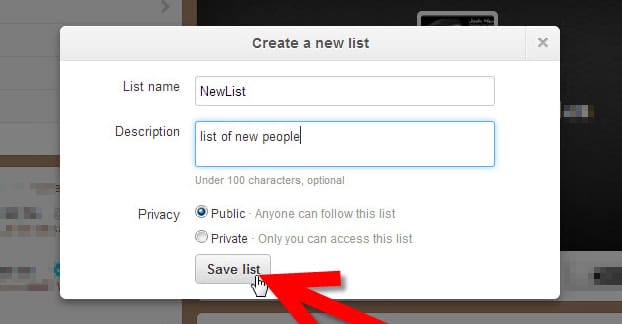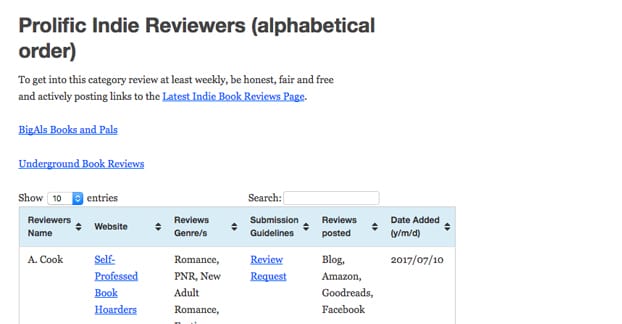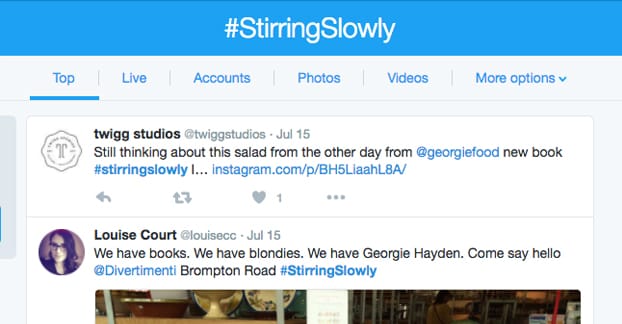Twitter isn’t just for brands and businesses. It’s not just for casual users posting jokes at each other. It’s not just for YouTube producers, tossing their new videos to the winds. Anyone can carve out their niche, up to and including authors.
Now, authors have a special relationship with Twitter. At first glance it seems hard for someone used to writing hundreds of thousands of words at a time to condense thoughts into 140 characters. It’s truly not that difficult. Think about cover blurb reviews, elevator pitches, and other such short form supplementary work. That’s what authors can do with Twitter.
What I’ve done is compiled a list of possible ways an author can promote him or herself on Twitter. They’re all simple and relatively easy to do, with the agility an author is afforded and the casual atmosphere they’re allowed to take.
1. Link to Your Website for Book Preorders
Obviously, the number one way to promote your book is to directly promote your book. Ideally, you will have a stand-alone website set up, probably with a blog for longer-format posting. You should have a landing page for promoting the book, which you can link in your Twitter posts. I recommend posting about it about once every week or so, and pinning one particularly engaging post to the top of your feed at all times. This way, your URL is always visible and people are always going to be aware of it.
You don’t want to overdo it with the promotional links, however. Remember that a lot of your followers are already fans enough to have visited your site and probably know about the book already. The promotion is a small part of what you do on Twitter.
2. Encourage Engagement and Thank Readers
Twitter is a social network, which means you need to be social on it. The bulk of your time is going to be spent interacting with people, either people whose attention you want to get, or people who want to get your attention. Ideally, you will monitor your notifications and look for people who are trying to say something. Respond to them in an appropriate way.
- Someone want to hire you? Put them in contact with your agent.
- Someone thanking you for inspiring them? Retweet and thank them.
- Someone leaving criticism? Explain your reasoning and thank them.
- Someone leaving a hate message? Ignore them.
There are all different sorts of engagement you can get up to on Twitter. A big part of using the site effectively is staying active, and engaging with your followers is a great way to do that.
3. Follow Other Writers and Earn Writer Follows
This one is pretty easy. I created a test profile that hasn’t even published anything as an author – the name isn’t recognizable – and just put a description with “writer” in it. I then followed a few big name authors, like George R.R. Martin, Neil Gaiman, and Margaret Atwood. That account has seen a slow but steady stream of other writers following it, people who have published content themselves, though they aren’t big names with verified profiles like the ones I followed.
This was just a test profile and I’ve done nothing with it, yet that much works. Imagine how much more you can do if you follow those writers back and build a professional network with them.
4. Create a List of People Whose Attention You Want
By list, here, I actually mean a Twitter List. These are essentially lists of people you would follow, and even can be following if you want, except it creates its own individual feed. You can browse these feeds individually, to see certain subsets of content. You don’t have to follow someone to add them to a list, so a list can be made up of just people you follow, people you don’t follow, or a mixture.
This one will be a private list of people you want to network with. They will typically be high profile authors, publishing house editors, and agents. In other words, people who connecting with them will benefit your career as an author. The reason you want to keep it private is because otherwise it becomes transparently a self-serving list.
5. Create a List of People You Wish to Help
This is a second private list you want to make, this time full of people on par with your level of authorship. They don’t have much more influence than you – they’re your peers – but helping them out can help you out when they turn the tables.
The idea with both lists is to put them together and then check them every day, much like you check your notifications. If you’re following more than a couple hundred people your normal feed will be pretty terrible to try to keep up with, so you’ll limit yourself mostly to your lists. Engage with the people you follow with those lists, and build relationships to the best of your ability. With the lists kept private, people will simply think you’re on top of the game by keeping up with them. This can go a long way towards growing a loyal following and having people return the favor.
6. Tease Elements of New Books
There’s an art to teasing the content of new upcoming books. You don’t want to spoil too many plot details or any of the twists, if you’re writing fiction. For more informational books, you don’t want to give away the juiciest secrets. On the other hand, you do have information you can give out.
Maybe a character is returning when they disappeared in a previous book; you can tease the return of someone. Maybe you have some statistics that your readers might not expect, but which will change their perception of an issue. Whatever it is, the idea is simple; tease it without revealing it. Build interest in the book without sacrificing the value it has to readers.
7. Weigh in on Trends
Many authors draw from life around them. Some, like fiction writers, convert it into allegory and reference. Some, the more politically active writers, pay close attention to events so they can log history appropriately and accurately. In any case, you generally need to show people that you have a connection to the world, and that you’re not just some high and mighty writer in an ivory tower, locked away from the world.
One of the easiest ways to do this is to follow trends. Twitter has a very good engine for capturing current events and displaying them to users; the trending sidebar hashtags. Keep an eye on those, and when one is relevant to you or your audience – or simply to the world at large – comment on it. As long as you don’t say something offensive, and thus alienate users, you should gain a bit more of the human touch you need to bond with your audience.
8. Find Book Reviewers and Offer Advance Copies
Another way you can be somewhat self-serving is use Twitter to look for book reviewers in your genre. Obviously, there will always be some high profile reviewers that everyone knows about. These people probably both already know about your upcoming book and may be getting it from your publisher already. You’re looking for the smaller bloggers, people with reasonable followings but without the huge pull of top-tier reviewers for large organizations.
Hook up with these people on Twitter. Send them a direct message and introduce yourself, pitch your book, and ask them if it sounds like something they would like to review. Don’t just send them a blind copy without a pitch; give them something to accept. Once they have that initial approval they’ll be more likely to give you a valuable, positive review, which you can benefit from when their audience buys your book. They benefit too, having authors promote their reviews, so it’s a win/win if you do it right.
9. Keep the Books Alive
This technique comes courtesy of J.K. Rowling, who you may know from the creation of the Harry Potter books. She has a long history on Twitter, where she spends a lot of time doing everything an author should. She engages with the common reader, she interacts with other authors, and most importantly, she answers questions, clarifies points, and generally keeps the Harry Potter fandom alive. She has spent years answering questions posed to her by fans, adding details and longevity to her incredibly popular series. In many ways, it’s what has kept her popularity alive while she struggles to follow up on a hit that cannot be topped.
10. Host a Cover Art Contest
Contests are a tried and true way of getting engagement from your readers. They’ve been used by businesses for ages, but authors are capable of using them as well. A cover art contest is great, because it gives your readers a title to work with and perhaps a few details to include, and it brings out their creativity.
You can choose any number of rewards, ranging from a contract to get the winner actually on the cover, to signed copies of the books, to other related merchandise. Granted, this method works better for engaging fiction than nonfiction, but that’s the price nonfiction authors have to pay.
11. Solicit Review Blurbs
Once your book is released, make it public that you’re accepting reviews. You can even set up a reviews section on your website, or officially sanction reviews on a third party site like GoodReads. Ideally, you will get people giving you quotes you can use to promote your book. Some will go on your site, some will go on third party sites, and some – with luck – will be influencers tweeting short blurbs you can then retweet for significant value on the social network.
As writers, it’s easy to get tunnel vision and forget that there’s more to life and more to Twitter than just your book. It’s good to have a bit of a work/life balance whatever your profession, but the same holds true for authors on Twitter as well. Share elements of your real life surrounding your book. Of particular interest tend to be pet antics, relationship stories, and personal trips. Authors are in a unique position where such personal stories can actually become benefits to their business simply because readers like to get to know their authors.
One of the core components of any Twitter marketing campaign is the hashtags.
Creating branded hashtags that aren’t used by other entities is important for keeping conversations in one place. Again, when you follow a lot of people, your feed becomes more or less unusable. You need some way other than notifications to see the discussion focusing on your books. Creating book-specific hashtags is that solution. You can even keep an eye out for fan-created hashtags and use those as well.
14. Run Twitter Ads
Alright, so just because you’re an individual doesn’t mean you’re limited in what you can do on Twitter. There’s no distinction between a business account and a personal account. You can, at any time, create ads simply by registering for the ads manager. It’s a complex process to optimize ads and get the most out of them, but they’re an entire facet of marketing your book that you can’t necessarily ignore, so long as you have the budget for it. Your organic feed is for your humanized posts; your ads are for the marketing content.
15. Be a Human Being
Above all else, the number one thing that helps anyone succeed on Twitter is a little humanity. Very rarely are bots able to gain any significant following, and those that do often fall out of favor very quickly. Being a human, rather than trying to be a brand, helps you gain that human connection and helps keep people interested in you. With that connection, you can sell more books, you can get people on your side for promotion, and you can expand your sphere of influence. The best part is, it’s natural. Authors don’t need to worry as much about a brand reputation; you can simple act and reap the rewards.











